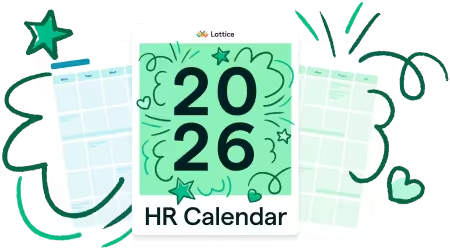Disciplinary Action Policy Template


Download this template for free
By submitting your information, you agree to Lattice's Terms of Service and Privacy Policy. You can opt out anytime.
Thanks! We'll be in touch soon.
Even in high-performing organizations, issues occasionally arise that require corrective action. Whether it’s a performance concern, a policy violation, or inappropriate conduct, companies need a clear and fair way to address problems — and give employees an opportunity to improve.
A disciplinary action policy outlines how your organization responds to misconduct or performance issues. It establishes the process, escalation steps, and employee rights — helping teams stay aligned, managers stay consistent, and employees understand what to expect.
When applied thoughtfully and respectfully, disciplinary actions don’t just resolve problems — they build trust in your culture of fairness and accountability.
What the Disciplinary Action Policy Should Include
A well-designed disciplinary policy should include:
- Policy purpose and scope: Who it applies to and what it covers.
- Definitions of misconduct and performance issues: Clarify what may trigger discipline.
- Types of disciplinary action: From informal feedback to formal warnings or termination.
- Progressive discipline framework: A step-by-step approach to escalating issues (if used).
- Employee rights and documentation: Expectations around transparency, feedback, and written records.
- Role of managers and HR: Who handles what during disciplinary processes.
- Appeal process: If applicable, how employees can respond or challenge disciplinary decisions.
- Statement of fairness and compliance: A reminder that disciplinary actions follow applicable laws and internal policies.
Purpose of the Disciplinary Action Policy
The purpose of this policy is to:
- Promote consistent and fair treatment of employees when issues arise.
- Provide a structured process for identifying, addressing, and resolving workplace problems.
- Support employee improvement through clear feedback and expectations.
- Protect the organization from legal and compliance risks by documenting disciplinary actions properly.
This policy is not meant to be punitive — it’s intended to protect the integrity of our culture and help employees succeed in their roles.
Sample Disciplinary Action Policy
{{rich-highlight-1}}
Effective Date: [Insert Date]
Policy Owner: People Team / HR Department
Last Reviewed: [Insert Date]
1. Policy Overview
[Company Name] is committed to maintaining a respectful, high-performance workplace. When issues of behavior, conduct, or performance arise, we believe in addressing them promptly, fairly, and consistently.
This policy outlines our process for disciplinary action, including what may trigger it, the steps we follow, and how employees can expect to be treated.
This policy applies to all employees, regardless of role or seniority.
2. Grounds for Disciplinary Action
Disciplinary action may be considered in cases such as:
- Repeated tardiness or unexcused absences
- Failure to meet job performance standards
- Insubordination or refusal to follow instructions
- Harassment, discrimination, or bullying
- Theft, fraud, or misuse of company property
- Violations of safety procedures or workplace policies
- Breach of confidentiality or data security protocols
- Workplace misconduct or unprofessional behavior
Each situation will be reviewed individually to determine appropriate next steps.
3. Types of Disciplinary Action
Depending on the severity and context of the issue, disciplinary action may include:
- Verbal warning: A documented conversation to inform the employee of the concern and expectations moving forward.
- Written warning: A formal document outlining the issue, required improvements, and potential consequences if the behavior continues.
- Performance improvement plan (PIP): A structured, time-bound plan that provides support and clear benchmarks for performance improvement.
- Final warning: A last opportunity to correct the issue before termination may be considered.
- Suspension: Temporary removal from duties, with or without pay, pending investigation or resolution.
- Termination: In cases of serious misconduct or ongoing failure to improve, employment may be ended.
Not every situation requires following each step in order. In cases of gross misconduct or serious violations, immediate termination may occur.
4. Progressive Discipline
Whenever appropriate, [Company Name] uses a progressive discipline model to help employees understand expectations and improve performance. This model is intended to give individuals the opportunity to correct behavior before more serious consequences are considered.
Progressive steps may include:
- Informal coaching or verbal warning
- Written warning
- Final warning or performance improvement plan (PIP)
- Termination
However, the company reserves the right to skip steps or take immediate action depending on the severity of the situation.
{{rich-highlight-3}}
5. Documentation
All disciplinary actions — verbal and written — should be documented and retained in the employee’s personnel file. Documentation should include:
- A description of the issue
- Date(s) of the incident(s)
- Steps taken to address the concern
- Employee response
- Next steps or expectations
Employees will be given a copy of any written warnings or PIPs and may be asked to sign acknowledgment of receipt. Signing does not necessarily indicate agreement — only confirmation that the document has been shared.
6. Role of Managers and HR
- Managers are responsible for identifying performance or conduct issues, addressing them promptly, and documenting conversations.
- HR / People Team is responsible for ensuring fairness, compliance, and documentation. HR must be consulted before issuing a written warning, implementing a PIP, or terminating employment.
Managers and HR will collaborate to ensure employees are treated consistently and with respect throughout the process.
7. Employee Response and Appeal
Employees are encouraged to share their perspective if they believe a disciplinary action was issued unfairly. Appeals may be submitted to HR in writing within 5 business days of receiving a written warning or formal disciplinary notice.
HR will review the situation and may gather additional information before determining next steps. While not every decision is reversible, every concern will be taken seriously.
8. Compliance and Equal Treatment
This policy complies with all applicable employment laws and regulations, including those related to discrimination, retaliation, and employee rights.
[Company Name] is committed to equitable treatment of all employees, regardless of race, gender identity, disability, age, sexual orientation, religion, or any other protected characteristic. Disciplinary decisions will be based solely on facts, behavior, and documented performance.
Frequently Asked Questions
1. Will I always get a warning before being fired?
Not necessarily. While we prefer to give employees a chance to improve, serious violations (e.g., harassment, theft, or violence) may result in immediate termination.
2. Can I bring someone with me to a disciplinary meeting?
In formal meetings involving written warnings or PIPs, you may request to have an HR representative or colleague present. This may vary by local laws or collective agreements.
3. Can I respond to a written warning?
Yes. You can submit a written response to HR if you disagree with the warning or want to provide additional context. Your response will be included in your personnel file.
4. What happens if I improve after being placed on a PIP?
If you meet all expectations in your performance improvement plan, the PIP will be closed and documented as successful. Ongoing performance will be monitored as usual.
5. Will disciplinary actions affect promotions or raises?
They can. Serious or recent disciplinary actions may delay promotions, raises, or bonuses. However, strong improvement and sustained performance can rebuild trust over time.
🚩 Please note: This sample policy is for informational purposes only and does not constitute legal advice. It is a generic template that may not suit your specific circumstances. When adopting or revising a policy, consult legal counsel to ensure compliance with all applicable laws and regulations.
✨ Disclaimer: This resource was developed with the help of artificial intelligence, though reviewed, edited, and approved by (real) humans.
Frequently Asked Questions

Your people are your business
Ensure both are successful with Lattice.





.webp)